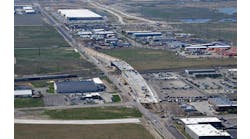By Elina Zlotchenko, Ned Schweikert, Carolina Burnier, and Barbara Staples, Contributing Authors
Many Americans face challenges in obtaining accessible transportation services. These challenges cost time, money, and, in some cases, independence. Each step in a journey—whether it’s via bus, car, sidewalk, or a combination of these—must transition seamlessly from one step to the next.
To address these challenges, the U.S. Department of Transportation (USDOT) launched the It’s Transportation for All of Us Deployment Program, or ITS4US.
Robert C. Hampshire, USDOT’s deputy assistant secretary for research and chief scientist, said he was proud that the Biden administration was investing “in technologies, innovations and partnerships that enhance access and mobility for all travelers, especially for communities that have been traditionally underserved or disadvantaged.”
Hampshire, who earned a Ph.D. in operations research and financial engineering, said the ITS4US program embodies the government’s priorities of “transportation equity, economic growth, sustainability, and most importantly, compassion and inclusivity.”
The multi-modal USDOT initiative includes support from its Intelligent Transportation Systems Joint Program Office, the Federal Highway Administration (FHWA), and the Federal Transit Administration (FTA).
The program leverages innovative technological solutions to augment transit agencies’ ability to provide safe, reliable, equitable, and efficient transportation.
By using targeted, scalable technologies to address specific steps in a complete trip, the deployments work in concert with existing services to ensure that travelers, some of whom might use wheelchairs for independent mobility, can get to where they need to go.
Through the ITS4US program, the USDOT is providing $40 million in support to four sites across the country: The Heart of Iowa Regional Transit Agency (HIRTA), the Georgia Department of Transportation (GDOT), the Niagara Frontier Transportation Authority (NFTA) in New York, and the University of Washington (UW). Each site is working on their own unique deployment tailored to their citizens who are in need and using input from local partners to sustainably build effective solutions for riders.
In addition to funding support, the USDOT provides technical assistance to the sites, with the overall program structured to give a robust foundation of systems engineering techniques and documentation to ensure the smooth rollout of all four projects.
The ITS4US program has three phases. In phase one, which concluded in 2022, the sites refined their deployment concepts and established partnerships with stakeholders and other local entities.
In phase two, which is ongoing, the sites will design and test their complete trip solutions.
In phase three, scheduled for 2024, they will begin their deployments and evaluate their projects to share data and lessons learned.
The program has already published 74 documents and held 24 public webinars. Knowledge sharing is a key focus for the ITS4US program, as it allows agencies across the country to get a jump start on their own deployments.
Similarly, USDOT and the project sites have also engaged with policy bodies to develop and propagate new modifications to existing standards to support accessibility and equity work that can benefit travelers across the country.
Strategic Goals
Each of the deployments under development in the ITS4US program addresses key parts of the complete trip, from planning to execution.
The deployments also emphasize the importance of targeting longstanding barriers to trips for underserved communities, like people with complete loss of sight.
In phase one, the four sites performed extensive stakeholder outreach to understand the transportation needs of the communities they serve and to ensure that participants’ voices were included in the design of the deployment and its operational goals.
By weaving this focus on equity and community participation through the entirety of the program, USDOT ensures that ITS4US is in alignment with the agency’s strategic goals.
The USDOT has mapped its priorities in its 2022-2026 strategic plan. The plan lays out six key goals: safety, equity, economic strength, climate, transformation, and organizational excellence. The ITS4US program aligns with these goals by specifically furthering equity, economic growth, and sustainability.
Equity
The strategic goal of equity is centered on ensuring that transportation projects increase opportunity for all people and bring communities together. USDOT seeks to address historic inequities, reduce barriers, and build a more inclusive transportation system.
The Safe Trips in a Connected Transportation Network (ST-CTN) system being developed by GDOT is an example of a tool that will help to improve equitable access to transportation.
The system, which will create a trip planner that will be free to users, is designed to help travelers with disabilities and those with limited English proficiency to navigate the transit system safely and effectively. By centering accessible transportation modes, GDOT will enable underserved travelers to be confident in planning trips to access jobs, services, and recreation.
Similarly, the Transportation Data Equity Initiative, led by the University of Washington, is working to expand three existing international data standards to enable public and private entities to collect, store, and share data on pathway accessibility.
By expanding these data standards, trip planners will be able to provide safer and more reliable pathing information to all users, increasing the transparency of walkway access and helping all travelers make safe, reliable decisions about how they can connect different stages of their trip.
Economic Growth
By extending transit systems to areas and communities that have been historically underserved, and by ensuring that all travelers have access to an unbroken trip chain to get to their destination, the ITS4US program is helping to break down historical barriers to economic growth and independence.
In Iowa, the health connector deployment project led by HIRTA connects underserved populations with inclusive transportation access to healthcare services. By using indoor and outdoor wayfinding and integrated booking technology to address existing barriers to trip planning and navigation, the project will connect users to the services they need effectively and reliably.
Similarly, in New York, the all access project led by NFTA will use a trip planner, intersection crossing technology, and an automated shuttle to improve mobility to, from, and within the Buffalo Niagara Medical Campus and the surrounding area.
NFTA’s deployment, in addition to connecting people with necessary medical services, will resonate within the larger Buffalo region to promote flexible, multimodal journeys to and from local businesses.
Sustainability
Agencies must also consider long-term sustainability in their services—shared-use transportation is a key tool to reduce overall emissions levels from transportation, with such modes on average halving greenhouse gas emissions per traveler.
Each ITS4US site contributes to sustainability efforts by facilitating shared modes and providing travel options to users beyond single-occupant vehicles (SOVs).
The self-driving shuttle being deployed by NFTA, for example, provides an alternative option for people trying to access jobs, businesses, and recreation in Buffalo’s downtown, enabling a non-SOV complete trip. Likewise, the trip planners being designed by HIRTA, GDOT, and NFTA will show users a complete list of transportation options available to them, reducing the mental load of planning a transit journey with multiple operators and encouraging mixed-mode journeys.
The expansion of data standards being undertaken by the UW team will feed higher-quality data into such trip planners, ensuring that travelers who use assistive mobility devices can be confident their trip will take them across only accessible sidewalks and intersections as they travel to, from, or between transit hubs.
The ITS4US projects are also sustainable in a different sense: Each is designed to be scalable, replicable, and long-lasting. The strong foundation of systems engineering documents that each site is creating and publishing ensure that the deployments will be resilient to risk, and the publications may be used and referenced by other agencies seeking to implement similar projects on their own.
In this way, the technical support being provided by USDOT to the four sites can have a magnified impact in helping agencies across the country manage the deployment of technically complex transportation solutions.
Moreover, as part of the terms of the ITS4US program, each site will continue operations of their deployment for a minimum of five years after the formal end of phase three. The projects will continue to provide benefits for the communities they are serving for a long time—potentially indefinitely.
Next Steps
The ITS4US program is currently halfway through phase two, with sites in the process of acquiring their technology solutions and establishing testing plans. In the second half of the phase, they will conduct tests to ensure that their implementations work as planned.
Then, as phase three starts, the deployments will go live and be continuously monitored to evaluate their success. These evaluations will include those conducted by the sites themselves and an additional review by an independent evaluator.
The evaluations will use metrics gathered by the sites and publicly published to determine the success of each deployment, as measured relative to the service goals identified in phase one.
The evaluations also will generate best practices and lessons learned that may be distributed along with the other materials being published by the ITS4US program. R&B
Elina Zlotchenko is a program manager at USDOT, Ned Schweikert is a transportation analyst at Noblis, Carolina Burnier is deputy program manager – surface transportation division at Noblis, and Barbara Staples is senior principal Noblis.



